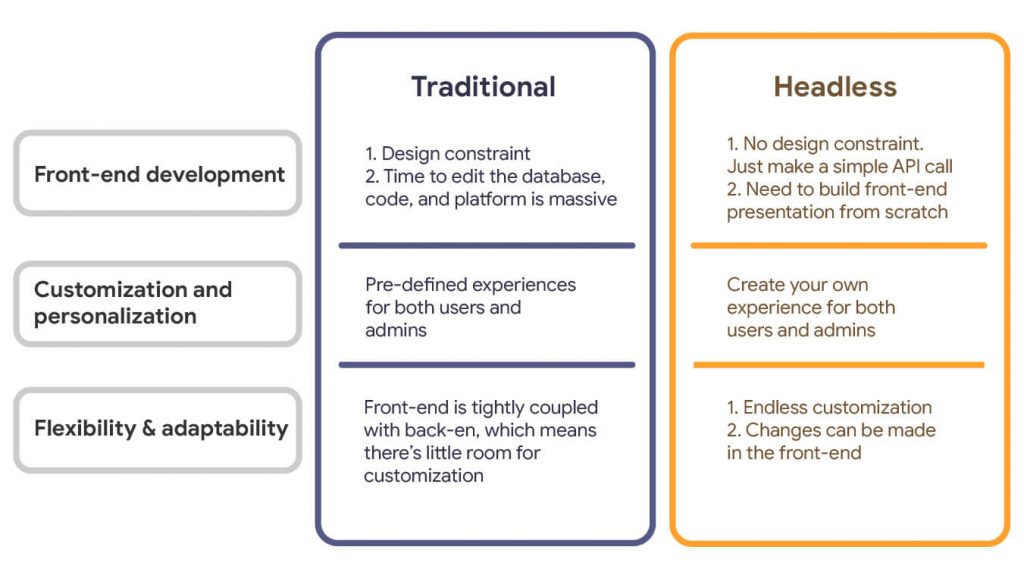Table of contents
If anyone could know what will be big for the Magento community this year, it would be the leading Magento experts. In this article revealing this year’s trends for the eCommerce industry, we see some new faces in the pre-existing trends—namely the headless commerce trend and the Progressive Web App movement.
Let’s not keep you waiting and dig into this whole thing:
Headless Commerce
Highly encouraged by Magento themselves, headless commerce is a recent trend that proves to be especially fitting for online stores that require the robust content delivery and flexibility of the headless architecture to keep up in today’s fast moving and demanding eCommerce world.
To put it in layman’s terms, headless commerce is a situation where the front-end of a site is decoupled from the eCommerce platform and other systems. The ‘presentation layer’ (the front-end) is separated from the commerce layer (the back end). Therefore, a retailer is able to gain more flexibility in serving rich content and user experience. Consequently, this makes website content more accessible across a wide range of channels, which was previously a challenging task for the traditionally monolithic architectures.

Related article
:
15 Best Examples of Headless Commerce in 2021
Progressive Web Apps (PWAs)
The typical shopping experience nowadays isn’t limited to just one channel. To their convenience, shoppers hop from one device to another, thus making mobile the starting and ending device for the majority of shoppers.

It’s due to this reason that we’re seeing Progressive Web App (PWA) an up and coming approach to eCommerce stores who want their shopping experience to be one the same across all devices. This consistency delivered by PWA, combined with its built-in features previously exclusive to native apps, is the main reason that brands who went Progressive can see their conversion rates vastly improved and their bottom line skyrocketed.
“This is a new technology that will inevitably grow and change over the years as developers constantly improve versions of it, and brands increasingly embrace PWAs as part of their mobile strategies.” – As stated by Peter Sheldon, vice president of strategy at Magento Commerce.

Augmented Reality
When mentioning Augmented Reality, people often make it out to be some futuristic, cutting-edge technology and not really something that is applicable. Well, apparently, 2021 is the year that Augmenter Reality shines.
No, really. What you’re (potentially) missing out in the current year is the fact that AR is already step-by-step replacing our everyday routine such as in-store navigation, manuals and even real-time try-ons.

Some of the bigger brands such as IKEA have already successfully implemented AR into their brands, enabling the ability for customers to customize, visualize and furnish in real scale.
See more: Magento Innovations Lab: Augmented Reality
Instant Purchase
The one-click checkout is proven to drive repeated purchases by making shopping easier and faster for your existing customers. Since Amazon’s exclusive ownership of the one-click checkout process has expired, Magento becomes the earliest adopter of this streamlined experience. Calling it Instant Purchase, they have made the Amazon-like checkout convenience available for free in the recent release of their platform – Magento 2.2.2. Providing a better way to stay competitive, the new standard feature is expected to become trending among Magento merchants.

Using previously saved billing, shipping, and payment details to skip checkout steps, Instant Purchase enables customers to place an order with a single click. All the customers would ever have to do is hit the Instant Purchase button and confirm the order on the pop-up which appears on the same page..
Removing unnecessary visits to cart and checkout pages, the feature can cut down over 90% on the time to complete an order, which means that not only it can potentially reduce frictions from the checkout flow, it can also trigger impulse purchases among customers as well.
Artificial Intelligent
The future is Artificial Intelligent—and this ranges from anything to everything, as the potential of machine learning isn’t limited to one single facet of eCommerce. With an AI-powered system in place, the following features are
- Customer care: The chatbots will take care of almost all of your customers’ needs since it’s the machine job to learn your customer’s most common question and answer accordingly. For more specific types of questions that your customers might ask, the bot will redirect the customers to your customer support team for further inquiries.
In fact, the chatbots are doing way too well which leads to rare occasions when extra measures are needed to determine if the person you’re talking to is real or not.

- Personalizations: Customers of 2021 no longer demand the typical browsing experience as not everyone’s needs are the same. It’s from this thinking that leads to the personalized experience commonly seen in streaming services and stores where personalized suggestions are the key to a successful platform.
- Image search: Using the latest machine learning algorithm, your customers can search and find any product that they want using pre-existing data.



